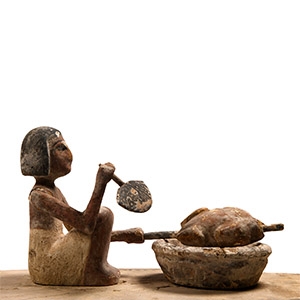Home > Stories by TimeLine Auctions
Stories by TimeLine Auctions
Brief Observations on Lot 4
 The hammer price + Bp (£5,200) achieved by Lot No. 0004 (Fowl-Roasting Scene) in TimeLine Auction's 23 May 23rd 2023 sale delighted all in attendance. Bidders and onlookers around the room seemed to share an empathic moment as the tableau of a cook roasting a spitted bird over a fire-bowl came under scrutiny. We have all been there; in Christmas kitchens, or around back-garden barbecues; attentively twiddling fan-assisted oven controls; or wafting charcoal briquettes to coax a little more heat to work its magic on the pallid pink poultry skin. Yet Lot No. 0004’s drama had first played out more than four thousand years earlier; on the flood plain of the ancient Nile .. Did cooks have fat fowl to roast in those distant days?
The hammer price + Bp (£5,200) achieved by Lot No. 0004 (Fowl-Roasting Scene) in TimeLine Auction's 23 May 23rd 2023 sale delighted all in attendance. Bidders and onlookers around the room seemed to share an empathic moment as the tableau of a cook roasting a spitted bird over a fire-bowl came under scrutiny. We have all been there; in Christmas kitchens, or around back-garden barbecues; attentively twiddling fan-assisted oven controls; or wafting charcoal briquettes to coax a little more heat to work its magic on the pallid pink poultry skin. Yet Lot No. 0004’s drama had first played out more than four thousand years earlier; on the flood plain of the ancient Nile .. Did cooks have fat fowl to roast in those distant days?
History and archaeology have, in fact, revealed a wide variety of birdlife thriving in Ancient Egypt; attracted by its fertile soils, its wetlands, and by the mighty river: swans, cranes, partridge, quail and doves numbering among the relatively easily caught wild birds; with geese, hens and ducks joining them later when domesticated flocks increased food supplies as Egypt’s population increased. Getting a bird into a cooking pot posed few problems; but finding enough fuel to roast it could bring increasingly difficult challenges. Egypt had a perpetual fuel shortage. Archaeology has revealed that the use of timber to fire pottery kilns, and to burn in high temperature furnaces when refining precious metals, and in the heating and forging of weapons, depleted much of Egypt’s large tree cover to the point where firewood for cooking purposes became too expensive for all but pharaohs and their households. Alternative fuel sources were desperately needed. They came, for the most part, from the rear ends of Egypt’s beast of burden; especially from donkeys, otherwise known as asses, which Egypt had in abundance. For example, it was recorded that during the Middle Kingdom, the lands of the Temple of Amun supported eleven million donkeys, kept in dairy herds. Throughout Ancient Egypt as a whole, trade and crop transportation depended solely on donkeys and on the Nile, until the introduction of camels in the first millennium BC. Donkey dung, used in conjunction with thin twigs harvested from the shrub known as the Nile tamarisk, proved an excellent fuel when burned in fire-bowls, and beneath other everyday cooking pots.
In her 1989 thesis Middle Kingdom Burial Customs: A Study Of Wooden Models And Related Material, AMJ Tooley describes wooden duck roaster scenes in which a kilted cook tends a fire as he turns a spitted duck held in his other hand and presents it to the flames. Another Egyptologist, Marleen De Meyer, describing the excavation of a robbed Isolated Middle Kingdom Tomb At Dayr Al-Barsha, encountered a model room with the remains of a probable model duck roasting scene. She wrote of it: Two wooden ducks were found in the model room, one with a spit stuck in from behind, the other from the front. It is likely that they functioned in a duck roasting scene rather than that they were being carried by offerings bearers, since the latter normally hold the ducks by the wings and not on a spit. In such scenes a person is often depicted fanning the fire. Possibly the fan blade that was also found in the model room should be considered together with the ducks.
On your next visit to Italy, try to make time for a visit to the Egyptian Museum at Turin, where you will find on display a wooden model very similar to our Lot No. 0004.
Michael Healy (Photographer), TimeLine Auctions, 26th May 2023




